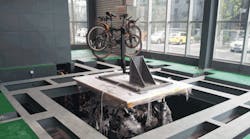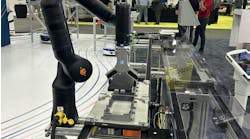Kemflo International Co. Ltd., Taiwan, entered the automotive accessories market in 2009 by acquiring U.S.-based Yakima Products, a maker of car racks and cargo boxes for carrying skis, bikes, and snow boards.
Developing home-grown R&D
After acquiring Yakima, Kemflo began establishing a research and development center in Nanjing, China. Yakima had a relationship with the test and simulation team at Moog Industrial Group, East Aurora, N. Y., prior to its acquisition by Kemflo, so Kemflo called on Moog to analyze the Chinese company’s needs, design a testing plan, and confirm auto testing specifications.
Moog recommended its six-degree-of-freedom hydraulic simulation table, a hydraulic service manifold, and Moog Integrated Test Suite software. The simulation table is capable of movement in X, Y, Z, roll, pitch, and yaw axes. Moog also helped Kemflo overcome challenges related to thermal insulation and preventing condensation throughout the entire hydraulic system. Within five months, Moog had installed and integrated the overall system and provided Kemflo with the training necessary for operation and advanced testing.
Simulating road wear
Kemflo uses its new hydraulic simulation table to mirror the different road conditions that its car racks encounter. It’s a complex undertaking to control each individual degree of motion because a movement along one axis involves using all of the simulation table’s six actuators. Kemflo engineers control all the actuators in terms of timing and speed, even as the table vibrates from 0 to 100 Hz.
To “road” test its products, Kemflo attaches the roof of a car (carrying a Kemflo car rack) on top of the simulation table. By simulating road conditions with proving ground data, the table precisely recreates the durability feedback Kemflo would gain from actually driving a vehicle. Engineers and designers use the table for virtually any test type or method on any Kemflo accessory.
Setting the table
Moog’s design was based on its experience with flight simulators using a hexapod approach. The hexapod uses six cylinders and two equilateral triangular frames set one above the other, offset at 30°. Each apex of the top triangle is connected to the two apexes below it on the lower triangle via actuators.
For this application, engineers designed hydraulic cylinders with hydrostatic bearings. The cylinders also have a proprietary seal design and piston rod coating to extend seal life beyond that of chrome plating and to resist corrosion.
Traditional hydrostatic cylinders use a four-pocket bearing design, but Kemflo’s table has an eight-pocket hydrostatic bearing design to improve each actuator’s side load capability. Four-pocket bearing designs can handle side loads of up to 40% of stall, but the eight-pocket design can handle up to 60%. This significantly increases test capabilities for the simulator.
All cylinders have a 99-mm bore and 80-mm diameter piston rod, with an overall actuator stroke of 272 mm and a working stroke of 203 mm. Each is fed by a 60-gpm servovalve. The simulation table is rated for nominal payloads to 680 kg, and achieves a frequency response of up to 100 Hz.
Quick and compact
High frequency multi-axis vibration testing with the hydraulic simulation table enables Kemflo to shorten the time taken for product testing and quality assurance. The table can run continuously for several days, a period equivalent to hundreds of thousands of road miles.
The simulation table occupies only one-third of the space of traditional shaker tables. The smaller size makes it easy to install, move and control in any place in the testing laboratory. This gives Kemflo additional space for personnel and other equipment in its R&D facility. The simulation table is also less costly to maintain than orthogonal designs because its six actuators are alike, so spare parts cost less.
For more information, visit www.mooginfo.com/kemflo/hp.


